Biodiversity of Colombia
Colombia is the country with the second-highest biodiversity in the world, behind Brazil.[1] As of 2016, 56,343 species are registered in Colombia, of which 9,153 are endemic. The country occupies the first position worldwide in number of orchids and birds, second position in plants, amphibians, butterflies and fresh water fish, third place in species of palm trees and reptiles and globally holds the fourth position in biodiversity of mammals.
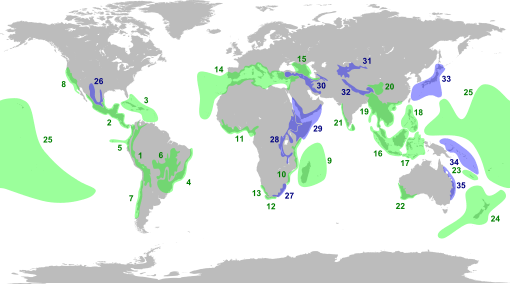
1 - Tropical Andes
5 - Tumbes-Chocó-Magdalena
The country hosts 59 nationally designated protected areas. At the establishment of the as of 2017 most recent addition, Bahía Portete – Kaurrele National Natural Park, Colombian president Juan Manuel Santos said "The biodiversity is to Colombia, what oil is for the Arabs".[2][3]
According to a report by the WWF, half of Colombia's ecosystems are in a critical state of deterioration or in a state of danger. The organization said that environmental degradation is due to oil extraction, mineral and metal extraction and deforestation. Deteriorating ecosystems are threatening the existence of more than a third of Colombia's plants and 50 percent of its animals.[4]
Description
Colombia is one of seventeen megadiverse countries in the world.[5] The country in northwestern South America contains 311 types of coastal and continental ecosystems.[1] As of 2016, a total of between 56,343 and 56,724 species are registered in the country,[6][7] with 9153 endemic species.[8] Colombia is the country with the most páramos in the world; more than 60% of the Andean ecosystem is found within Colombian territories.[9] Boyacá is the department where 18.3% of the national total area is located.[10] Since December 20, 2014, Colombia hosts 59 protected areas.[11] The biodiversity is highest in the Andean natural region, followed by the Amazon natural region.[12] Since 1998, the Humboldt Institute for Biological Resources in the country has been collecting samples of biodiversity. As of 2014, 16,469 samples, representing around 2530 species from 1289 genera, and 323 families of the Colombian biodiversity have been stored in their archives.[13]
The biodiversity of Colombia is at risk, mainly because of habitat loss, urbanisation, deforestation and overfishing.[14] According to a study of 2001, 260,000 hectares (640,000 acres) of forested area is lost every year.[15] Around 1200 species are critically endangered,[16] and 922 species are introduced in Colombia, 22 of which are classified as invasive species in Colombia.[17] Various plans to address the environmental issues are proposed.[18] The National System of Protected Areas (SINAP) is the administrator of protected areas.
Biodiversity in numbers
| Class | Group | Pos | Species |
|---|---|---|---|
| Vertebrates | Mammals (list, primates) | 4 | 492 |
| Birds (list, endemic) | 1 | 1941 | |
| Reptiles (list, lizards, snakes) | 3 | 537 | |
| Amphibians | 2 | 803 | |
| Marine fish | 2000 | ||
| Freshwater fish (Magdalena River) | 1435 | ||
| Invertebrates (arthropods) |
Lepidoptera (butterflies, moths) | 1 | 3274 |
| Ants | 900 | ||
| Marine molluscs | 1250 | ||
| Marine sponges | 1250 | ||
| Corals | 139 | ||
| Marine decapods | 560 | ||
| Echinoderms | 296 | ||
| Terrestrial molluscs | 650 | ||
| Beetles | 7000 | ||
| Arachnids | 1089 | ||
| Bees | 398 | ||
| Diptera | 3153 | ||
| Flora (endemic) | Flowering plants | 22,840 | |
| Flowerless plants | 45 | ||
| Orchids (endemic) | 1 | 4270 | |
| Ferns and relatives | 1643 | ||
| Palm trees | 3 | 289 | |
| Mosses and relatives | 1649 | ||
| Algae | Terrestrial algae | 1030 | |
| Marine algae | 565 | ||
| Fungi | Lichen | 1674 | |
| Macrofungi | 1239 | ||
| Rusts | 327 | ||
| Smuts | 71 | ||
To commemorate the biodiversity of Colombia, the coins of the Colombian peso introduced in 2012 feature a species each.[19]
Natural regions
Colombia is divided into six natural regions.
Caribbean natural region
.svg.png) |
Surface area | 132,288 km2 (51,077 sq mi) | |
| Departments | 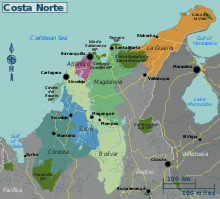 | ||
| National parks | Bahía Portete Ciénaga Grande Los Colorados Corales de Profundidad Corales del Rosario El Corchal Los Flamencos Macuira Paramillo Playona Acandí Salamanca Island S.N. de Santa Marta Tayrona | ||
| Biodiversity | aquatic birds | 165 | |
| amphibians | 39 | ||
| reptiles | 129 | ||
| plants | 3151 | ||
| fish | 109 | ||
| References | |||
Andean natural region
.svg.png) |
Surface area | 282,540 km2 (109,090 sq mi) | |
| Departments | |||
| National parks | Catatumbo Barí Chingaza El Cocuy Corota Cueva de los Guácharos Doña Juana-Cascabel Los Estoraques Galeras Guanentá Las Hermosas Iguaque Nevado del Huila Los Nevados Las Orquídeas Otún Quimbaya Pisba Puracé Selva de Florencia Sumapaz Tamá Tatamá Yariguíes | 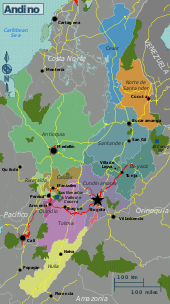 | |
| Biodiversity | aquatic birds | 14 | |
| amphibians | 485 | ||
| reptiles | 220 | ||
| plants | 11,500 | ||
| fish | 197 | ||
| References | |||
Orinoquía natural region
.svg.png) |
Surface area | 285,437 km2 (110,208 sq mi) | |
| Departments | |||
| National parks | La Macarena Los Picachos Tinigua El Tuparro | 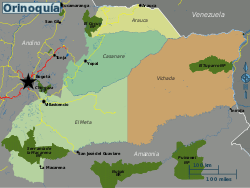 | |
| Biodiversity | aquatic birds | 92 | |
| amphibians | 57 | ||
| reptiles | 119 | ||
| plants | 2692 | ||
| fish | 619 | ||
| References | |||
Amazon natural region
.svg.png) |
Surface area | 483,911 km2 (186,839 sq mi) | |
| Departments | |||
| National parks | 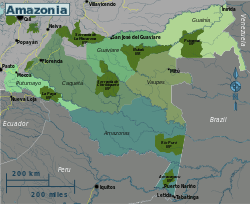 | ||
| Biodiversity | aquatic birds | 74 | |
| amphibians | 158 | ||
| reptiles | 195 | ||
| plants | 5300 | ||
| fish | 675 | ||
| References | |||
Pacific/Chocó natural region
.svg.png) |
Surface area | 83,170 km2 (32,110 sq mi) | |
| Departments | 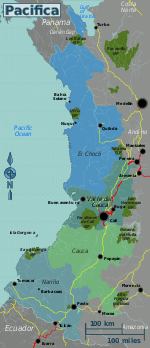 | ||
| National parks | Los Katíos Sanquianga Uramba Bahía Málaga Utría | ||
| Biodiversity | aquatic birds | 142 | |
| amphibians | 154 | ||
| reptiles | 177 | ||
| plants | 4525 | ||
| fish | 164 | ||
| References | |||
Insular natural region
.svg.png) |
Surface area | 300 km2 (120 sq mi) | |
| Departments |  | ||
| National parks | Corales del Rosario Malpelo Old Providence Gorgona | ||
| Biodiversity | Corales del Rosario y San Bernardo | ||
| fish | 170 | ||
| corals | 52 | ||
| sponges | 25 | ||
| molluscs & crustaceans | 100s | ||
| Gorgona Island | |||
| fish | Pseudobatos prahli | ||
| Trichomycterus gorgona | |||
| Malpelo Island | |||
| fish | Acanthemblemaria stephensi | ||
| Halichoeres malpelo | |||
| Old Providence Lagoon | |||
| birds | 74 | ||
| References | |||
Biodiversity hotspots
Colombia hosts two biodiversity hotspots; the Tropical Andes and Tumbes-Chocó-Magdalena. The country is part of the World Network of Biosphere Reserves with five biosphere reserves:[26]
| Name | Since | First review |
Second review |
Image | Notes |
|---|---|---|---|---|---|
| Cinturón Andino | 1979 | 2001 | 2011 | 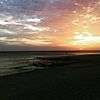 | |
| El Tuparro | 1979 | 2001 | 2011 |  | |
| Sierra Nevada de Santa Marta | 1979 | 2001 | 2011 |  | |
| Ciénaga Grande de Santa Marta | 2000 | 2011 | 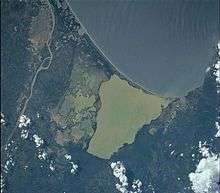 | ||
| Seaflower | 2000 | 2011 |
Species
.jpg)
Selected fauna
| Name | Species | Image |
|---|---|---|
| Caquetá titi | Callicebus caquetensis | |
| cotton-top tamarin | Saguinus oedipus | 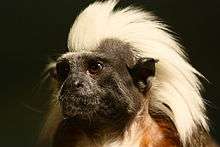 |
| mountain tapir | Tapirus pinchaque | 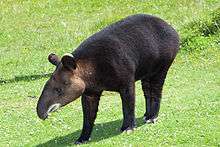 |
| ornate titi | Callicebus ornatus | 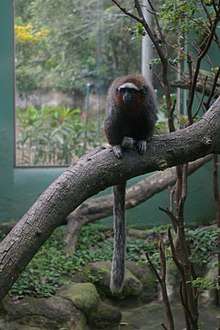 |
| spectacled bear | Tremarctos ornatus | |
| white-footed tamarin | Saguinus leucopus |  |
| Santamartamys | 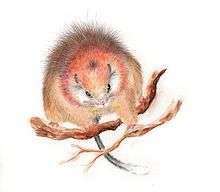 | |
| American flamingo | Phoenicopterus ruber | |
| Andean condor | Vultur gryphus | |
| blue-billed curassow | Crax alberti | 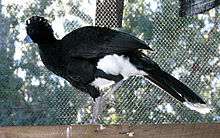 |
| Colombian chachalaca | Ortalis columbiana | |
| crested caracara | Caracara cheriway | |
| great egret | Ardea alba | .jpg) |
| green-bearded helmetcrest | Oxypogon guerinii | .jpg) |
| indigo-capped hummingbird | Amazilia cyanifrons | _(8079781711).jpg) |
| little blue heron | Egretta caerulea | .jpg) |
| multicoloured tanager | Chlorochrysa nitidissima |  |
| snowy egret | Egretta thula | 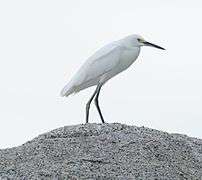 |
| white-tailed starfrontlet | Coeligena phalerata | .jpg) |
| blue anole | Anolis gorgonae | |
| Magdalena River turtle | Podocnemis lewyana | %2C_Medellin.jpg) |
| rainbow whiptail | Cnemidophorus lemniscatus | |
| spectacled caiman | Caiman crocodilus | |
| Norops mariarum | 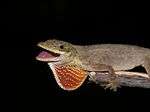 | |
| Andean poison frog | Andinobates opisthomelas | 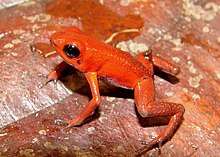 |
| Boettger's Colombian treefrog | Dendropsophus columbianus |  |
| golden poison frog | Phyllobates terribilis |  |
| Guajira stubfoot toad | Atelopus carrikeri |  |
| harlequin poison frog | Oophaga histrionica |  |
| Lehmann's poison frog | Oophaga lehmanni | 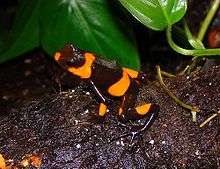 |
| Pristimantis tayrona | .jpg) | |
| green discus | Symphysodon tarzoo | |
| redhump eartheater | Geophagus steindachneri |  |
| spotted moray | Gymnothorax moringa | 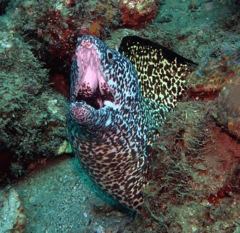 |
| Malpelo barnacle blenny | Acanthemblemaria stephensi | 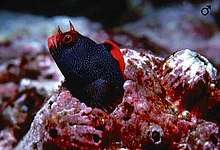 |
| Malpelo wrasse | Halichoeres malpelo | |
| Centrochir crocodili | 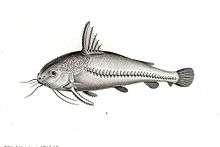 | |
| Hoplosternum magdalenae | 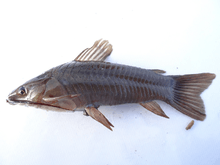 | |
| Labrisomus dendriticus | 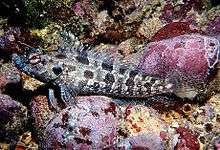 | |
| Sturisoma aureum |  | |
| Clysonymus longwing | Heliconius clysonymus | 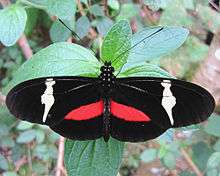 |
| Dirce beauty | Colobura dirce | 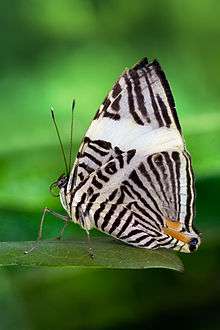 |
| brown peacock | Anartia amathea | .jpg) |
| eleone white | Leptophobia eleone | .jpg) |
| short-lined kite swallowtail | Protographium agesilaus | |
| Rhetus arcius |  | |
| Mastigoproctus colombianus | 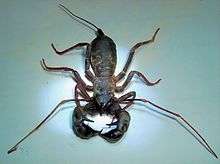 | |
| Psammodesmus bryophorus | 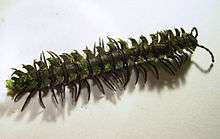 | |
| giant ramshorn snail | Marisa cornuarietis | 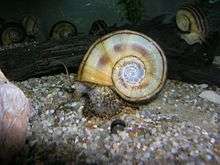 |
| Portuguese man o' war | Physalia physalis | 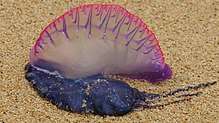 |
| sea slug |  | |
Selected endemic flora
| Name | Species | Image |
|---|---|---|
| Cattleya trianae national flower |
 | |
| wax palm | Ceroxylon quindiuense national tree |
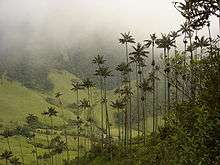 |
| lulo | Solanum quitoense national fruit |
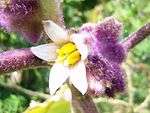 |
| borojó | Alibertia patinoi |  |
| Ancipitia anthrax | 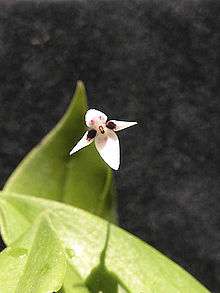 | |
| Comparettia macroplectron | 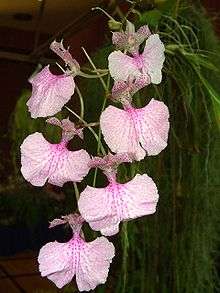 | |
| Dracula bella | 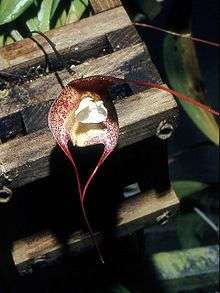 | |
| Dracula diabola | 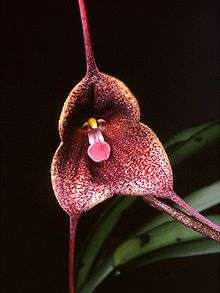 | |
| Dracula lotax | 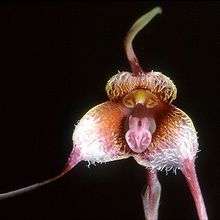 | |
| Erythroxylum novogranatense | 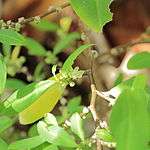 | |
| frailejón | Espeletia killipii | 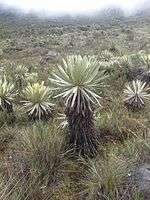 |
| Heliconia bourgaeana | ||
| Hypericum myricariifolium | .jpg) | |
| Ipomoea pes-caprae | .jpg) | |
| Lepanthes ophelma | 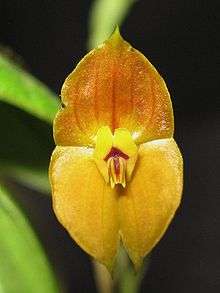 | |
| Lupinus alopecuroides |  | |
| Masdevallia mejiana | 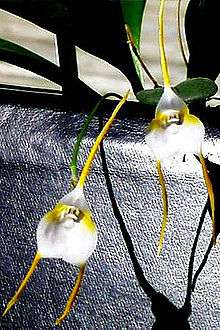 | |
| Miconia salicifolia | ||
| Monnina salicifolia | .jpg) | |
| Odontoglossum crispum | 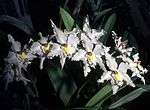 | |
| Opuntia wentiana | .jpg) | |
| Paphinia rugosa | 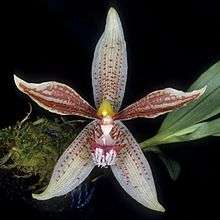 | |
| Paphinia seegeri | 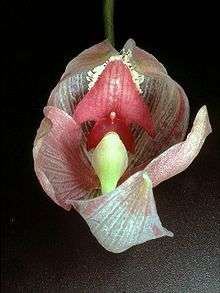 | |
| Passiflora loefgrenii | 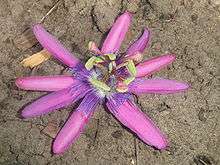 | |
| Pentacalia vernicosa | 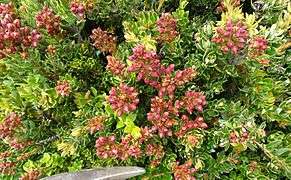 | |
| Phragmipedium schlimii |  | |
| color-changing Restrepia | Restrepia chameleon | 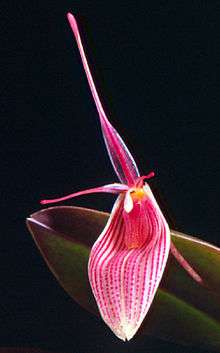 |
| copper-coloured Restrepia | Restrepia cuprea | 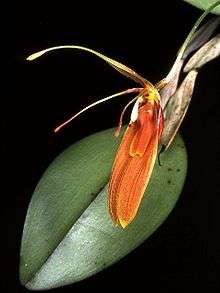 |
| Restrepia nittiorhyncha | 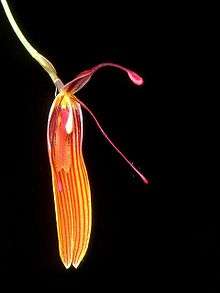 | |
| Restrepia pandurata |  | |
| Senecio formosoides | .jpg) | |
| Stanhopea platyceras | 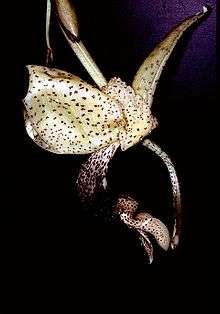 | |
| Stanhopea pozoi | 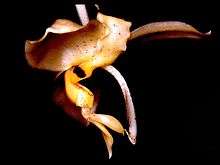 | |
| Stanhopea shuttleworthii | 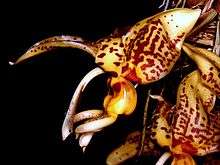 | |
| Stanhopea stevensonii |  | |
Selected endemic fungi
| Name | Species | Image |
|---|---|---|
| Cookeina tricholoma | 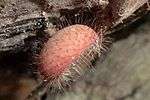 | |
| Favolus brasiliensis | _Fr_498949.jpg) | |
| Oudemansiella platensis | _Speg_498959.jpg) | |
Panoramas
See also
References
- (in Spanish) Qué es la biodiversidad - Humboldt Institute
- (in Spanish) Nuevo Parque Nacional Natural de Colombia Bahía Portete - Ministerio de Ambiente, Colombia
- (in Spanish) Bahía Portete, regalo de Navidad - El Espectador
- Colombia Viva:Informe 2017 - WWF-Colombia
- Biodiversity A-Z
- (in Spanish) Biodiversidad en Colombia
- SiB, 2016, p.1
- SiB, 2016, p.3
- Five unmissable Colombian páramos begging to be explored
- Nieto Escalante et al., 2010, p.75
- (in Spanish) Parques Nacionales de Colombia
- (in Spanish) Estadísticas Biodiversidad Colombia
- Arbeláez Cortés et al., 2015, p.163
- UNDP, 2014, p.18
- Rodríguez Becerra, 2001, p.10
- SiB, 2016, p.6
- SiB, 2016, p.8
- (in Spanish) Plan de acción de biodiversidad Colombia 2016-2030
- (in Spanish) Biodiversidad nuestra conexión vital - Banco de la República
- Woods, 2008, p.49
- Kyne, P.M. (2016). "Pseudobatos prahli". IUCN Red List of Threatened Species. 2016: e.T63158A104002851. doi:10.2305/IUCN.UK.2016-3.RLTS.T63158A104002851.en.
- Villa-Navarro, F., Mesa-Salazar, L., Sanchez-Duarte, P. & Lasso, C. (2016). "Trichomycterus gorgona". IUCN Red List of Threatened Species. 2016: e.T64792679A64890625. doi:10.2305/IUCN.UK.2016-1.RLTS.T64792679A64890625.en.CS1 maint: multiple names: authors list (link)
- Bessudo, S., Dominici-Arosemena, A., Espinosa, H. & Hastings, P. (2010). "Acanthemblemaria stephensi". IUCN Red List of Threatened Species. 2010: e.T183968A8208246. doi:10.2305/IUCN.UK.2010-3.RLTS.T183968A8208246.en.CS1 maint: multiple names: authors list (link)
- Allen, G., Edgar, G., Rocha, L. & Min, L. (2010). "Halichoeres malpelo". IUCN Red List of Threatened Species. 2010: e.T183519A8127170. doi:10.2305/IUCN.UK.2010-3.RLTS.T183519A8127170.en.CS1 maint: multiple names: authors list (link)
- Villegas, Benjamin, and Laura Sesana. 2007. Colombia Natural Parks. Villegas Asociados. Accessed 2017-01-30.
- World Biosphere Reserves - Latin America & The Caribbean
- Cinturón Andino - World Biosphere Reserve
- El Tuparro - World Biosphere Reserve
- Sierra Nevada de Santa Marta - World Biosphere Reserve
- Ciénaga Grande de Santa Marta - World Biosphere Reserve
- Sea Flower - World Biosphere Reserve
Bibliography
- Arbeláez Cortés, Enrique; María Fernanda Torres; Diana López Álvarez; Juan Diego Palacio Mejía; Ángela María Mendoza, and Claudia Alejandra Medina. 2015. Colombian frozen biodiversity - 16 years of the tissue collection of the Humboldt Institute - La biodiversidad congelada de Colombia: 16 años de la colección de tejidos del Instituto Humboldt. Acta Biológica Colombiana - Universidad Nacional de Colombia 20. 163-173.
- Nieto Escalante, Juan Antonio; Claudia Inés Sepulveda Fajardo; Luis Fernando Sandoval Sáenz; Ricardo Fabian Siachoque Bernal; Jair Olando Fajardo Fajardo; William Alberto Martínez Díaz; Orlando Bustamante Méndez, and Diana Rocio Oviedo Calderón. 2010. Geografía de Colombia - Geography of Colombia, 1-367. Instituto Geográfico Agustín Codazzi.
- Rodríguez Becerra, Manuel. 2001. La biodiversidad en Colombia, 1-32. Accessed 2017-01-30.
- SiB, .. 2016. Biodiversidad en cifras, 1-9. Sistema de Información sobre Biodiversidad de Colombia. Accessed 2017-01-30.
- UNDP, .. 2014. V Informe nacional de biodiversidad de Colombia - ante el convenio de diversidad biológica, 1-156. United Nations Development Program. Accessed 2017-01-30.
- Woods, Sarah. 2008. Colombia. Bradt Travel Guides. Accessed 2017-01-30.

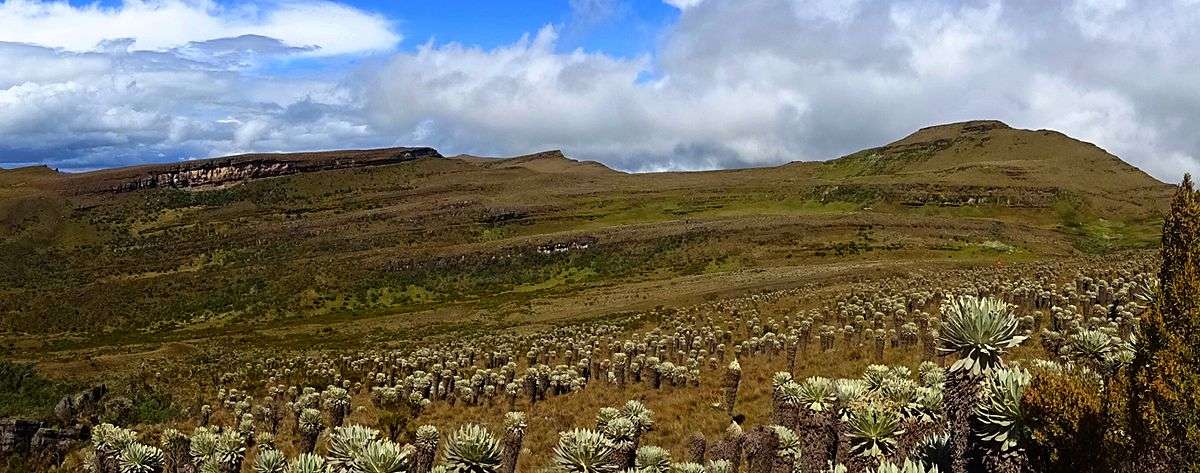
.svg.png)
.svg.png)
